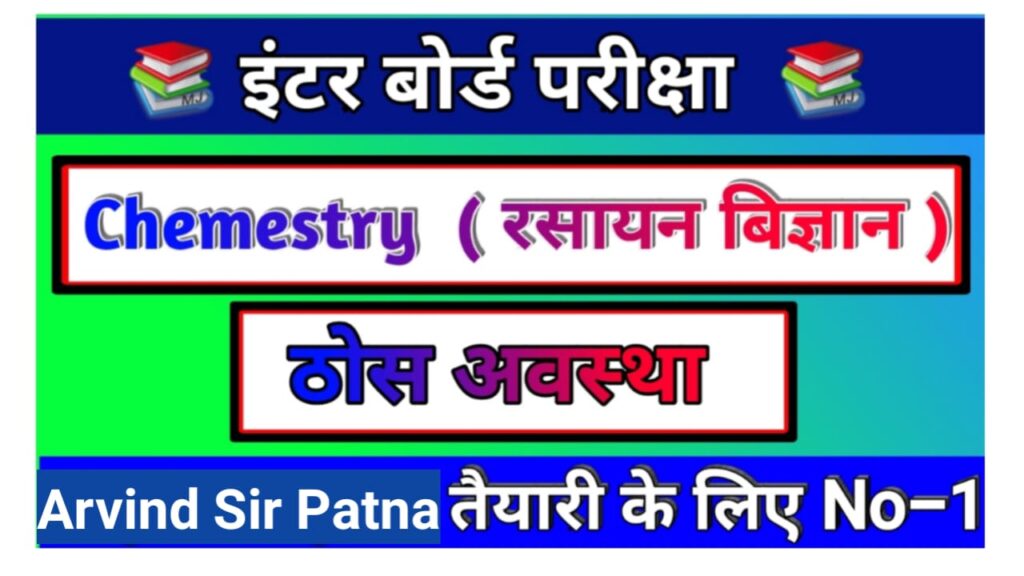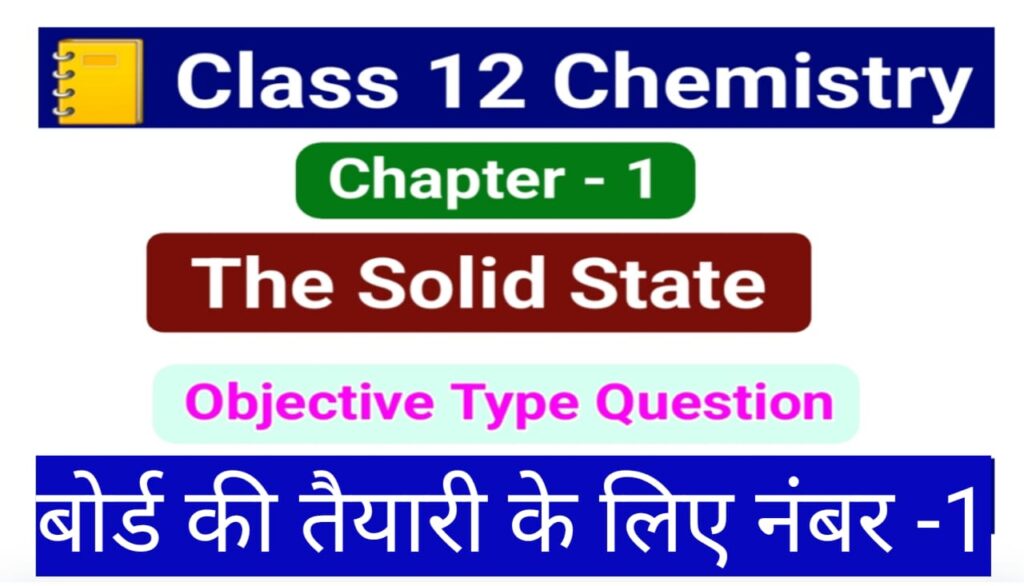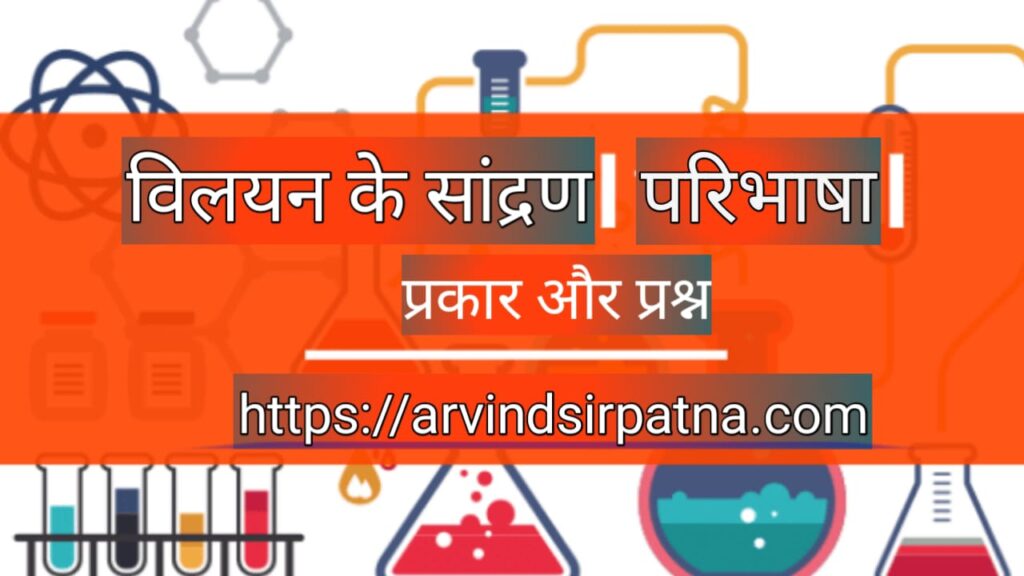बिहार बोर्ड परीक्षा 2022 Chemistry पेपर Answer जानने के लिए Main Menu पर जाये |
- सभी लिगेंड होते हैं।
(A) लेविस अम्ल (B) लेविस भस्म (C) उदासीन (D) इनमें से कोई नहीं
All ligands are
(A) Lewis acids (B) Lewis bases (C) Neutral (D) None of these
- निम्नलिखित में कौन अनुचुम्बकीय है ?
Which of the following is paramagnetic ?
(A) Ni(CO)4 (B) [Ni(CN)4]2- (C) [NiCl4] 2- (D) [Co(NH3)6]3+
- निम्नलिखित में किस जैव अणु का Mg एक प्रमुख संघटक है ?
(A) हीमोग्लोबिन (B) क्लोरोफिल (C) फ्लोरीजेन (D) ATP
Magnesium is an important component of which biomolecule ?
(A) Haemoglobin (B) Chlorophyll (C) Florigen (D) ATP
- वह जटिल आयन जिसमें केन्द्रीय धातु परमाणु में कोई -इलेक्ट्रॉन नहीं है, है
The complex ion in which central metal atom has no d-electron is
(A)[MnO4]– (B) [Co(NH3)6]3+ (C) Fe(CN)6]3- (D) [Cr (H2O)6]3+
- कौन कथन गलत है ?
(A) Ni(CO)4 – चतुष्फलकीय, अनुचुम्बकीय (B) [Ni (CN)4]2- – वर्गतलीय, प्रतिचुम्बकीय
(C) [Ni(NH3)6]2+ – अष्टफलकीय, अनुचुम्बकीय (D) [NiCI4]2- – चतुष्फलकीय, अनुचुम्बकीय
Which statement is incorrect?
(A) Ni(CO)4 – Tetrahedral, paramagnetic (B) [Ni (CN)4]2- – Square planar, diamagnetic
(C) [Ni(NH3)6]2+ – Octahedral, paramagnetic (D) [NiCI4]2- -Tetrahedral, paramagnetic
- निम्नलिखित में किस यौगिक का उपयोग अग्निशामक में होता है ?
(A) CCl4 (B) CHCL3 (C) CH3CI (D) COCl2
Which of the following compounds is used in fire extinguisher?
(A) CCl4 (B) CHCL3 (C) CH3CI (D) COCl2
- मोनोहेलोजन व्युत्पन्न ऐल्कोहॉलिक KOH के साथ अभिक्रिया कर देता है
(A) ऐल्केन (B) ऐल्कीन (C) ऐल्काइन (D) ऐलिसाइक्लिक हाइड्रोकार्बन
Monohalogen derivative on reaction with alcoholic KOH gives
(A) Alkane (B) Alkene (C) Alkyne (D) Alicyclic hydrocarbon
- वह अभिकर्मक जिसका उपयोग ब्यूटेन-1 ऑल से 1 ब्रोमोब्यूटेन बनाने में होता है, है
The reagent which is used to prepare 1-Bromobutane from Butan-1-ol is
(A) CHBr3 (B) Br₂ (C) CH3Br (D) PBr3
- निम्नलिखित में कौन यौगिक बनता है जब
Which of the following compounds is formed when
C6H6 + Cl2 (आधिक्य) सूर्य प्रकाश
- क्लोरोजीन (B) p- डाइक्लोरोबॅजीन (C) क्लोरोजीन (D) बेंजीन क्लोराइड
- निम्नलिखित में कौन आयोडोफार्म परीक्षण देता है ?
Which of the following gives iodoform test ?
(A) CH3OH (B) (CH3)2CHOH (C) (CH3)3 COH (D) CH3-CH2-CH2-OH
- निम्नलिखित में किससे बड़े पैमाने पर मेथिल ऐल्कोहॉल बनाया जाता है ?
(A) पाइरोलिग्नियस अम्ल से (B) शीरा के किण्वन से
(C) मेथिल क्लोराइड की अभिक्रिया अनार्द्र Ag20 से कराकर (D) मेथिल ऐमीन की अभिक्रिया HNO2 से कराकर
From which of the following is methyl alcohol prepared on a large scale?
(A) From pyroligneous acid (B) From fermentation of molasses
(C) By reacting methyl chloride with dry Ag2O (D) By reacting methylamine with HNO2
- निम्नलिखित में कौन-सा क्रियाशील मूलक ऐल्कोहॉल में उपस्थित रहता है ?
Which of the following functional groups is present in alcohol?
(A) – OH (B) – CHO (C) C=O (D) -NH2
- निम्नलिखित में कौन सर्वाधिक अम्लीय है ?
(A) फिनॉल (B) बेजिल ऐल्कोहॉल (C) m-क्लोरोफिनॉल (D) साइक्लोहेक्सेनॉल
Which of the following is the most acidic ?
(A) Phenol (B) Benzyl alcohol (C) m-chlorophenol (D) Cyclohexanol
- प्राइमरी ऐल्कोहॉल का उत्प्रेरक निर्जलीकरण से मिलता है
(A) कीटोन (B) ईस्टर (C) सेकेण्डरी ऐल्कोहॉल (D) ऐल्डिहाइड
Catalytic dehydrogenation of primary alcohol gives
- Ketone (B) Ester (C) Second alcohol (D) Aldehyde
- जब ऐसीटिलीन को तनु H2SO4 से HgSO4 की उपस्थिति में प्रवाहित किया जाता है, तब जो यौगिक बनता है, वह है
(A) ऐथिल ऐल्कोहॉल (B) ऐसीटोन (C) ऐसीटल्डिहाइड (D) Hg का कार्बाइड
When acetylene is passed through dil. H2SO4 in the presence of HgSO4, the compound formed is
(A) Ethyl alcohol (B) Acetone (C) Acetaldehyde (D) Carbide of Hg
- निम्नलिखित में कौन ऐल्डॉल संघनन नहीं देता है ?
(A) मेथेनल (B) ऐथेनल (C) प्रोपेनोन (D) प्रोपेनल
Which of the following does not give Aldol condensation ?
(A) Methanal (B) Ethanal (C) Propanone (D) Propanal
- जब फार्मल्डिहाइड की अभिक्रिया अमोनिया से करायी जाती है तो निम्नलिखित में किस यौगिक का निर्माण होता है ?
(A) फार्मल्डिहाइड (B) हेक्सामिथीलीन टेट्रामीन (C) फार्मलिन (D) मेथिल ऐमीन
When formaldehyde reacts with NH3, then which of the following compounds is formed ?
(A) Formaldehyde ammonia (B) Hexamethylene tetramine
(C) Formalin (D) Methylamine
- निम्नलिखित में कौन ईस्टर का क्रियाशील मूलक है ?
Which of the following is the functional group of an ester ?
(A) – CHO (B) –CONH2 (C) – COOR (D) – COOCO –
- निम्नलिखित में किसके द्वारा फार्मिक अम्ल एवं फार्मल्डिहाइड में अन्तर किया जा सकता है ?
(A) बेनेडिक्ट का घोल (B) टॉलेन का अभिकर्मक (C) फेहलिंग का घोल (D) सोडियम बाइकार्बोनेट
By which of the following can formic acid and formaldehyde be distinguished ?
(A) Bendict’s solution (B) Tollen’s reagent (C) Fehling’s solution (D) Sodium bicarbonate
- अभिक्रिया, RCOOAg + Br2 ccl ͢ RBr + AgBr + CO2 को कहते हैं
(A) HVZ अभिक्रिया (B) हंसडीकर अभिक्रिया (C) हॉफमैन अभिक्रिया (D) कार्बिल ऐमीन अभिक्रिया
The reaction, RCOOAg+ Br2 ccl ͢ RBr + AgBr + CO2 is called
(A) HVZ reaction (B) Hunsdicker reaction (C) Hoffmann reaction (D) Carbylamine reaction
- रासायनिक अभिक्रिया, 2O3 É 3O2 निम्न प्रकार से होती है
O3 É O2 + O (तीव्र)
O+O3 É 2O2 (मंद)
तो इस अभिक्रिया का वेग समीकरण है।
(A) Rate = K[03]2 (B) Rate = K[O3]2[02]-1 (C) Rate = K [O3] [O2] (D) Rate = K[O3] [O2]2
The chemical reaction, 203É 302 proceeds as follows:
O3 É O2 + O (fast)
O+O3 É 2O2 (slow)
then the rate law expression of this reaction is
(A) Rate = K[03]2 (B) Rate = K[O3]2[02]-1 (C) Rate = K [O3] [O2] (D) Rate = K[O3] [O2]2
- अधिकांश अभिक्रियाओं के लिए ताप गुणक का मान निम्नलिखित में किसके बीच में रहता है ?
(A) 2 और 3 (B) 1 और 2 (C) 2 और 4 (D) 3 और 4
The temperature coefficient of most of the reactions lies between which of the following?
(A) 2 and 3 (B) 1 and 2 (C) 2 and 4 (D) 3 and 4
- निम्नलिखित में कौन लायोफिलिक कोलॉइड नहीं है ?
(A) दूध (B) गोंद (C) कुहासा (D) खून
Which of the following is not a lyophilic colloid ?
(A) Milk (B) Gum (C) Fog (D) Blood
- कोलॉइडी कर्णो का निम्नलिखित में किसके बीच होता है ?
(A) 10-7-10-9 cm (B) 10-9-10-11 cm (C) 10-5-10-7 cm (D) 10-2-10-3 cm
The size of the colloidal particles is in between which of the following?
(A) 10-7-10-9 cm (B) 10-9-10-11 cm (C) 10-5-10-7 cm (D) 10-2-10-3 cm
- स्टार्च के जल अपघटन में निम्नलिखित में किस इंजाइम का उपयोग होता है ?
(A) माल्टेज (B) जाइमेज (C) इनवर्टेज (D) डायस्टेज
Which of the following enzymes is used in the hydrolysis of starch?
(A) Maltase (B) Zymase (C) Invertase (D) Diastase
- रासायनिक अधिशोषण की दर
(A) दाब बढ़ने से घटती है (B) दाब पर निर्भर नहीं करती है।
(C) एक वायुमंडलीय दाब पर अधिकतम होती है (D) दाब बढ़ने से बढ़ती है।
The rate of chemisorption.
(A) decreases with increase in pressure (B) is independent of pressure
(C) is maximum at one atmospheric pressure (D) increases with increase in pressure
- पृथ्वी की परत में सबसे अधिक मात्रा में पाया जाने वाला धातु है।
The most abundant metal in earth crust is
(A) Al (B) Fe (C) Ca (D) Na
- पायरोलिग्नियस अम्ल में रहता है।
Pyroligneous acid contains
- 2% acetic acid (B) 50% acetic acid (C) 10% acetic acid (D) 20% acetic acid
- जलीय घोल में निम्नलिखित में सबसे सबल भस्म कौन है ?
Which of the following is the strongest base in aqueous solution?
(A) C6H5NH2 (B) CH3NH2 (C) (CH3)2NH (D) (CH3)3N
- C3H9N अणु-सूत्र के द्वारा निम्नलिखित में किसे व्यक्त किया जाता है ?
(A) प्राइमरी ऐमीन (B) सेकेण्डरी ऐमीन (C) टर्शियरी ऐमीन (D) इनमें से सभी
Which of the following can be represented by molecular formula C3H9N ?
(A) Primary amine (B) Secondary amine (C) Tertiary amine (D) All of these
- निम्नलिखित में किसको अबकृत करने से सेकेण्डरी ऐमीन प्राप्त होता है ?
(A) नाइट्राइल (B) नाइट्रो यौगिक (C) काबिल ऐमीन (D)ऐमाइड
Which of the following is reduced to get a secondary amine ?
(A) Nitrile (B) Nitro compound (C) Carbylamine (D) Amide
- गन्ने की चीनी के जल अपघटन से निम्नलिखित में क्या मिलता है ?
(A) सिर्फ ग्लूकोस (B) ग्लूकोस एवं माल्टोस (C) ग्लूकोस एवं फ्रक्टोस (D) ग्लूकोस एवं लैक्टोस
Cane sugar on hydrolysis gives which of the following ?
(A) Only glucose (B) Glucose and maltose (C) Glucose and fructose (D) Glucose and lactose
- इंजाइम हैं
(A) कार्बोहाइड्रेट (B) लिपिड (C) प्रोटीन (D) इनमें से कोई नहीं
Enzymes are
- Carbohydrates (B) Lipids (c) Proteins (D) None of these
- निम्नलिखित में कौन ऑक्सीकारक एवं अवकारक दोनों की तरह व्यवहार करता है ?
(A) H₂S (B) H2SO4 (C) SO2 (D) SO3
Which of the following acts both as oxidising as well as reducing agents?
(A) H₂S (B) H2SO4 (C) SO2 (D) SO3
- निम्नलिखित में कौन रंगीन होता है ?
(A) NH3 (B) NO2 (C) N20 (D) NO
Which of the following is coloured?
(A) NH3 (B) NO2 (C) N20 (D) NO
- संक्रमण तत्वों का सामान्य इलेक्ट्रॉनिक विन्यास है।
The general electronic configuration of transition elements is
(A) (n-1)d5 (B) (n-1)d¹-10 ns0,1or2 (C) (n-1)d¹-10 ns1 (D) ns2np6
- निम्नलिखित में किसमें Mn की ऑक्सीकरण संख्या न्यूनतम है ?
In which of the following is the oxidation state of Mn lowest ?
(A) MnSO4 (C) Mn304 (B) MnO2 (D) Mn2O7
- निम्नलिखित में कोन ऐक्टनाइड नहीं है ?
(A) क्यूरियम (B) कैलीफोर्नियम (C) यूरेनियम (D) टर्बियम
Which of the following is not an actinide?
(A) Curium (B) Californium (C) Uranium (D) Terbium
- निम्नलिखित में कौन आयन रंगहीन है ?
Which of the following ions is colourless?
(A) Cu+ (B) Co2+ (C), Ni2+ (D) Fe3+
- निम्नलिखित में कौन आयन प्रतिचुम्बकीय है ?
Which of the following ions is diamagnetic?
(A) Cr³+ (B) V+2 (C) Sc³+ (D) Ti3+
- निम्नलिखित में किसका हिमांक अवनमन अधिकतम होगा ?
(A) K2SO4 (B) NaCl (C) यूरिया (D) ग्लूकोस
Which of the following will have maximum depression in freezing point?
(A) K2SO4 (B) NaCl (C) Urca (D) Glucose
- 1 फैराडे के बराबर होता है।
1 Faraday is equal to
(A) 9,650 कूलम्ब (B) 10,000 कूलम्ब (C) 19,640 कूलम्ब (D) 96,500 कूलम्ब
- जब लेड संचय सेल को चार्ज किया जाता है, तो निम्नलिखित में क्या होता है ?
(A) लेड डाईआक्साइड घुलता है (B) H2SO4 पुनः उत्पन्न होता है।
(C) लेड इलेक्ट्रोड के ऊपर लेड सल्फेट का परत जम जाता है। (D) गंधकाम्ल का सांद्रण घट जाता है
What happens when a lead storage battery is charged ?
(A) Lead dioxide dissolves (B) Sulphuric acid is regenerated
(C) Lead electrode becomes coated with lead sulphate (D) The concentration of sulphuric acid decreases
- हाइड्रोजन ऑक्सीजन सेल निम्नलिखित में किस तरह का सेल है ?
(A) प्राथमिक सेल (B) द्वितीयक सेल (C) ईंधन सेल (D) लेड संचायक सेल
Hydrogen-oxygen cell is which of the following types of cell?
(A) Primary cell (B) Secondary cell (C) Fuel cell (D) Lead storage cell
- किसी रासायनिक अभिक्रिया की दर
(A) समय के साथ बढ़ती है। (B) समय के साथ घटती है
(C) समय के साथ घट या बढ़ सकती है (D) समय के साथ स्थिर रहती है
The rate of a chemical reaction
(A) increases with time (B) decreases with time
(C) may increase or decrease with time (D) remains constant with time
- निम्नलिखित में कौन प्रथम कोटि की अभिक्रिया नहीं है ?
Which of the following is not a first order reaction ?
(A) CH3COOC2H5+ H2O H+É CH3 COOH + C2H5OH
(B) CH3COOC2H5 + NaOH É CH3COONa+ C₂H5OH
(C)2H202 É 2H2 O+O2 (D) 2N2O5 É 4NO2 + 02
- विटामिन C
(A) ऐस्कॉर्बिक अम्ल (B) निकोटिनिक अम्ल (C) साइट्रिक अम्ल (D) टारटरिक अम्ल
Vitamin C is
(A) Ascorbic acid (B) Nicotinic acid (C) Citric acid (D) Tartaric acid
- निम्नलिखित में किसमें कोबाल्ट उपस्थित है ?
(A) क्लोरोफिल (B) हिमोग्लोबिन (C) विटामिन C (D) विटामिन B12
Which one of the following contains cobalt ?
(A) Chlorophyll (B) Haemoglobin (C) Vitamin C (D) Vitamin B12
- निम्नलिखित में कौन योगशील बहुलक है ?
(A) नायलॉन 6 (B) नायलॉन 6,6 (C) उच्च घनत्व वाले पोलिथीन (D) डैक्रोन
Which of the following is an addition polymer?
(A) Nylon-6 (B) Nylon-6, 6 (C) High density polythene (D) Dacron
- F2C = CF2 निम्नलिखित में किसका एकलक है ?
(A) टेफ्लॉन (B) ग्लाईप्टल (C) नायलॉन 6 (D) ब्यूना- S
F2C = CF2 is a monomer of which of the following ?
(A) Teflon (B) Glyptal (C) Nylon-6 (D) Buna-S
- क्लोरोक्वीन है एक
(A) दर्द नाशक (B) एंटीबायोटिक (C) ऐंटीमैलेरियल (D) ज्वर नाशक
Chloroquine is an
(A) analgesic (B) antibiotic (C) antimalarial (D) antipyretic
- निम्नलिखित में कौन ऑड स्पेक्ट्रम एंटीबायोटिक नहीं है ?
(A) टेट्रासाइक्लीन (B) क्लोरोमाइसेटीन (C) पेनिसिलीन (D) इनमें से कोई नहीं
Which of the following is not a broad spectrum antibiotic?
(A) Tetracycline. (B) Chloromycetin (C) Penicillin (D) None of these
- निम्नलिखित में कौन गैमेक्सीन है ?
(A) क्लोरोबेंजीन (B) DDT (C) बेंजीन हेक्साक्लोराइड (D) इनमें से कोई नहीं
Which of the following is Gammexane ?
(A) Chlorobenzene (B) DDT (C) Benzene hexachloricle (D) None of these
- सल्फाइड अयस्कों का सांद्रण प्रायः निम्नलिखित में किसके द्वारा होता है ?
(A) गुरुत्व पृथक्करण विधि (B) चुम्बकीय पृथक्करण विधि
(C) फेन उत्प्लावन विधि (D) कार्बन अवकरण विधि
Sulphide ores are generally concentrated by which of the following?
(A) Gravity separation process (B) Magnetic separation process
(C) Froth floatation process (D) Carbon reduction process
- निम्नलिखित में कौन धातु का निष्कर्षण विद्युत विच्छेदन की क्रिया के द्वारा नहीं होता है ?
Which of the following metals is not extracted by the process of electrolysis?
(A) Na (B) Mg (C) AL (D) Fe
- हूप की विधि के द्वारा निम्नलिखित में किस धातु का शोधन होता है ?
Which of the following metals is purified by Hoope’s process?
(A) Cu (B) Al (C) Fe (D) Zn
- निम्नलिखित में कौन सबसे कम क्वथनांक वाली गैस है ?
(A) हाइड्रोजन (B) हीलियम (c) नाइट्रोजन (D) आर्गन
Which of the following is the gas with lowest boiling point?
(A) Hydrogen (B) Helium (C) Nitrogen (D) Argon
- निम्नलिखित में कौन सिर्फ एक ही आक्सोअम्ल बनाता है ?
Which of the following forms only one oxyacid?
(A) F2 (B) Cl2 (c) Br₂ (D) I2
- S8 में सल्फर की आक्सीकरण अवस्था है
The oxidation state of S in S8 is
(A) + 2 (B) +4 (C) +8 (D) 0
- निम्नलिखित में कौन सबसे कम वाष्पशील है ?
Which of the following is the least volatile ?
(A) H₂ Se (B) H₂ Te (C) H₂S (D) H₂O
- धनाकार क्रिस्टल में ब्रेवेस जालकों की संख्या होती है
The number of Bravais lattices in a cubic crystal is
(A) 3 (B) 1 (C) 4 (D) 14
- एक अष्टफलक रिक्ति निम्नलिखित में कितने गोलों से घिरी होती है ?
An octahedral void is surrounded by which of the following numbers of spheres ?
(A) 4 (B) 6 (C) 8 (D) 12
- निम्नलिखित में किस प्रकार के दोष के कारण क्रिस्टल के घनत्व में कमी होती है ?
(A) फ्रेंकेल (B) सॉट्की (C) अंतराली (D) F- केन्द्र
Which of the following types of defects causes a decrease in density of a crystal ?
(A) Frenkel (B Schottky (C) Interstitial (D) F-centre
- निम्नलिखित में कौन फेरोचुम्बकीय पदार्थ है ?
Which of the following is a ferromagnetic substance?
(A) NaCl (B) Fe3O4 (C) 02 (D) N2
- विलयन के अनुसंख्य गुणधर्म का उदाहरण है
(A) घनत्व (B) द्रव्यमान (C) क्वथनांक उन्नयन (D) ताप
An example of colligative property of a solution is
(A) Density (B) Mass (C) Elevation of boiling point (D) Temperature
- घोलक के 1 kg में उपस्थित घुल्य के मोलों की संख्या को कहते हैं.
(A) मोलरता (B) मोललता (C)नार्मलता (D) मोल प्रभाज
The number of moles of solute per kg of solvent is called
(A) Molarity (B) Molality (C) Normality (D) Mole fraction
- वैसा घोल जो एक निश्चित ताप पर संयोजन में बिना किसी प्रकार के परिवर्तन के उबलता है, उसे कहते हैं
(A) एजियोट्रोपिक मिश्रण (B) असंतृप्त (C) अतिसंतृप्त (D) आदर्श
Solutions which boil at a constant temperature without any change in composition is called
(A) Azeotropic mixture (B) Unsaturated (C) Supersaturated (D) Ide










